Abstract
Inhibition of the proliferation of Ehrlichia risticii cultured in murine macrophage P388D1 cells by eight antibiotics was evaluated by indirect fluorescent-antibody staining with an antiserum specific to E. risticii. There was a negative correlation between the percentage of infected cells and the log10 of the concentrations of all antibiotics examined. The ranks of the antibiotics in the order of 50% inhibitory concentrations (on a microgram-per-milliliter basis) after 48 h of exposure were as follows: demeclocycline, doxycycline, and oxytetracycline less than minocycline less than rifampin less than tetracycline less than erythromycin and nalidixic acid. When the antibiotics were removed after 48 h of incubation, continuous inhibition of proliferation was evident at 72 h. At 96 h regrowth of the organisms occurred in most of the cultures. The rate of regrowth was the highest with nalidixic acid, followed by erythromycin, at all concentrations of the antibiotic tested. Regrowth was observed with less than 0.1 microgram of minocycline per ml and less than 0.01 microgram of oxytetracycline, tetracycline, and doxycycline per ml. With more than 0.01 microgram of demeclocycline per ml, however, the inhibition persisted for up to 72 h after removal of the antibiotic. These results indicate that demeclocycline was slightly more effective than doxycycline, oxytetracycline, and minocycline in eliminating E. risticii in macrophages in vitro, whereas tetracycline and rifampin were less effective. Nalidixic acid and erythromycin were ineffective.
Full text
PDF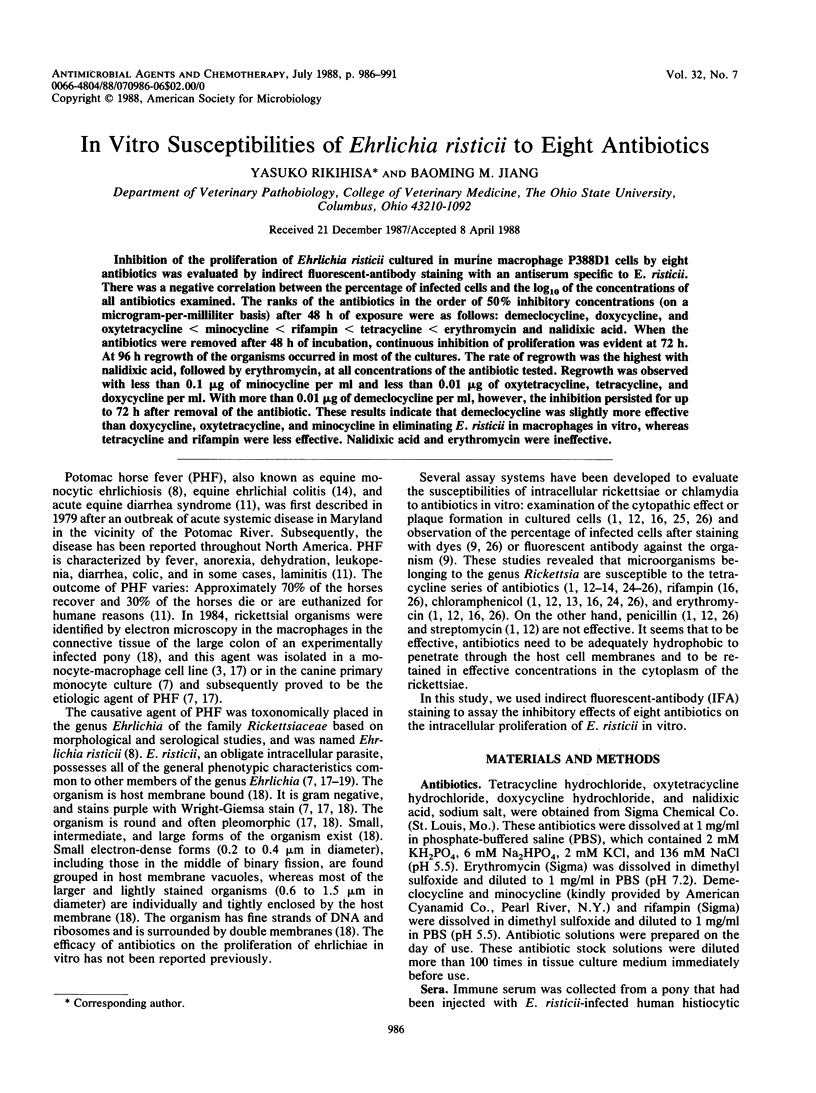
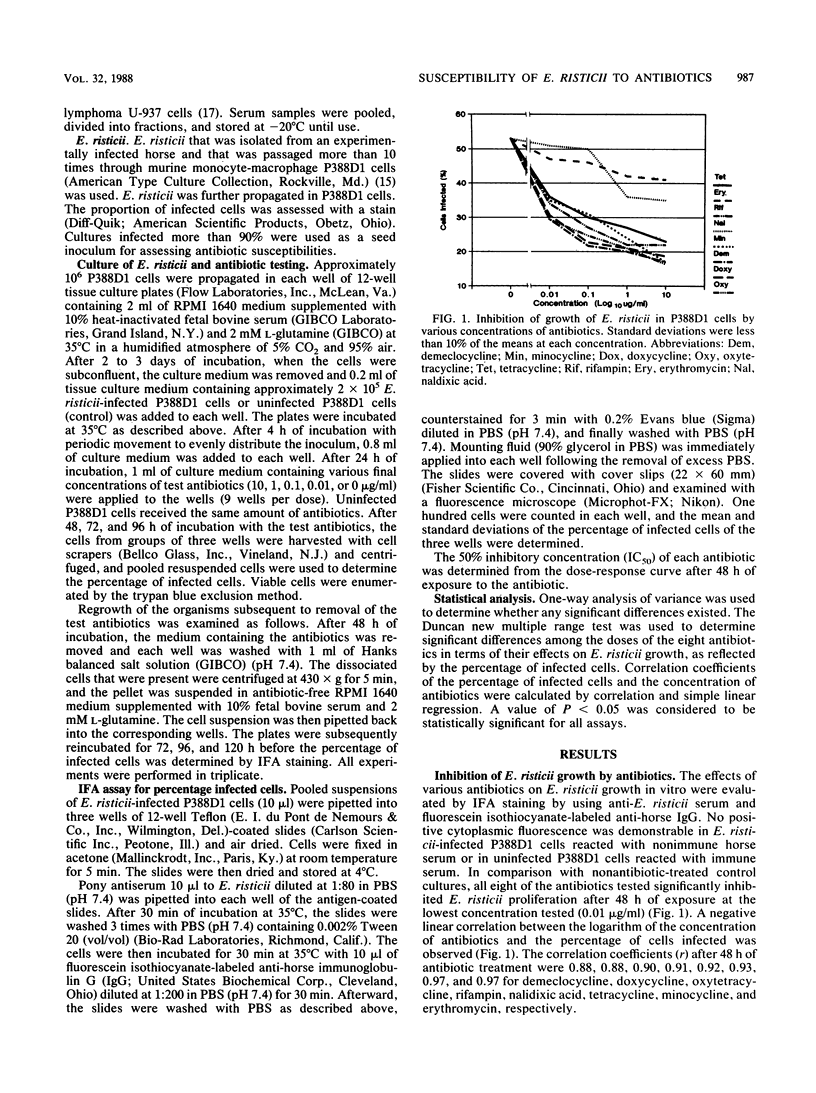
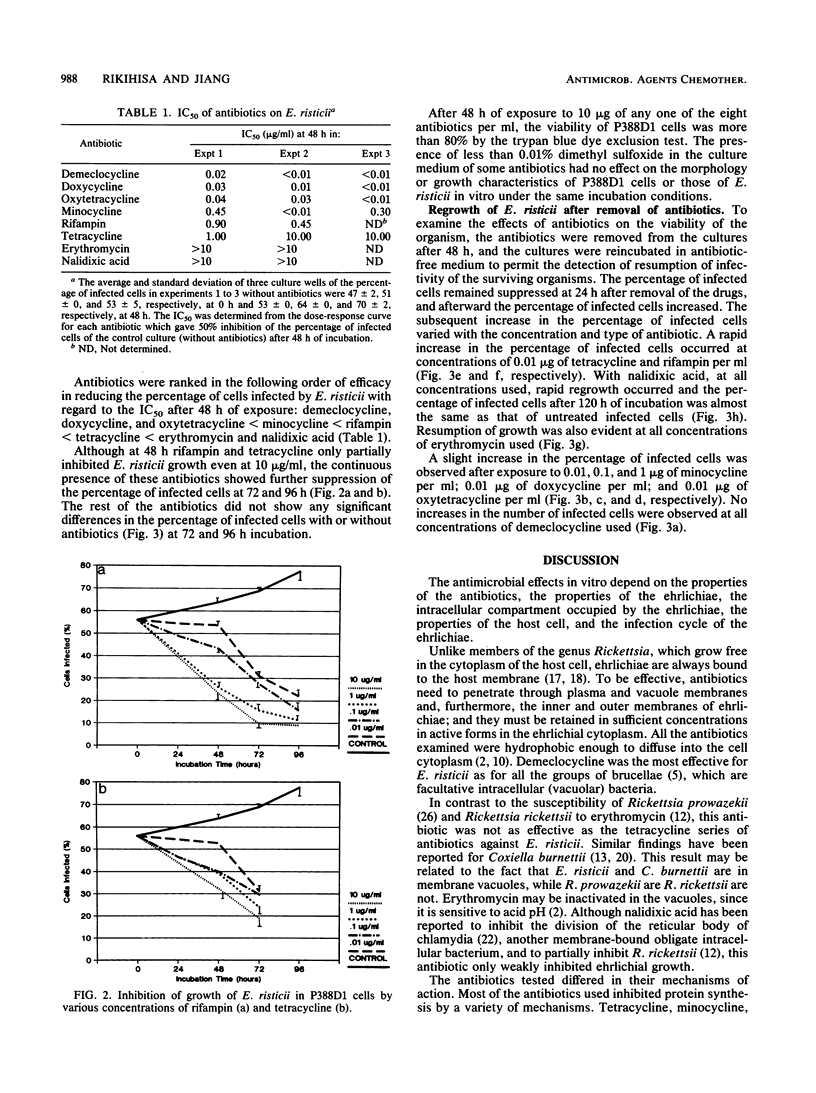
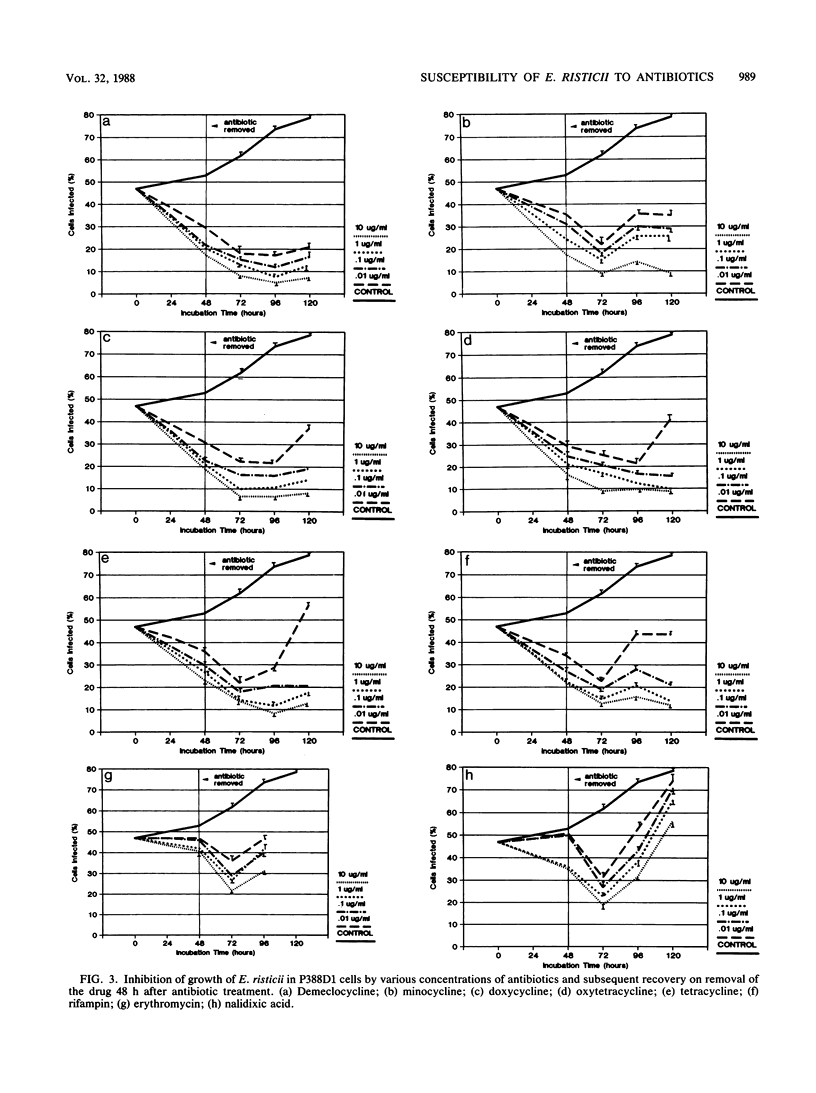
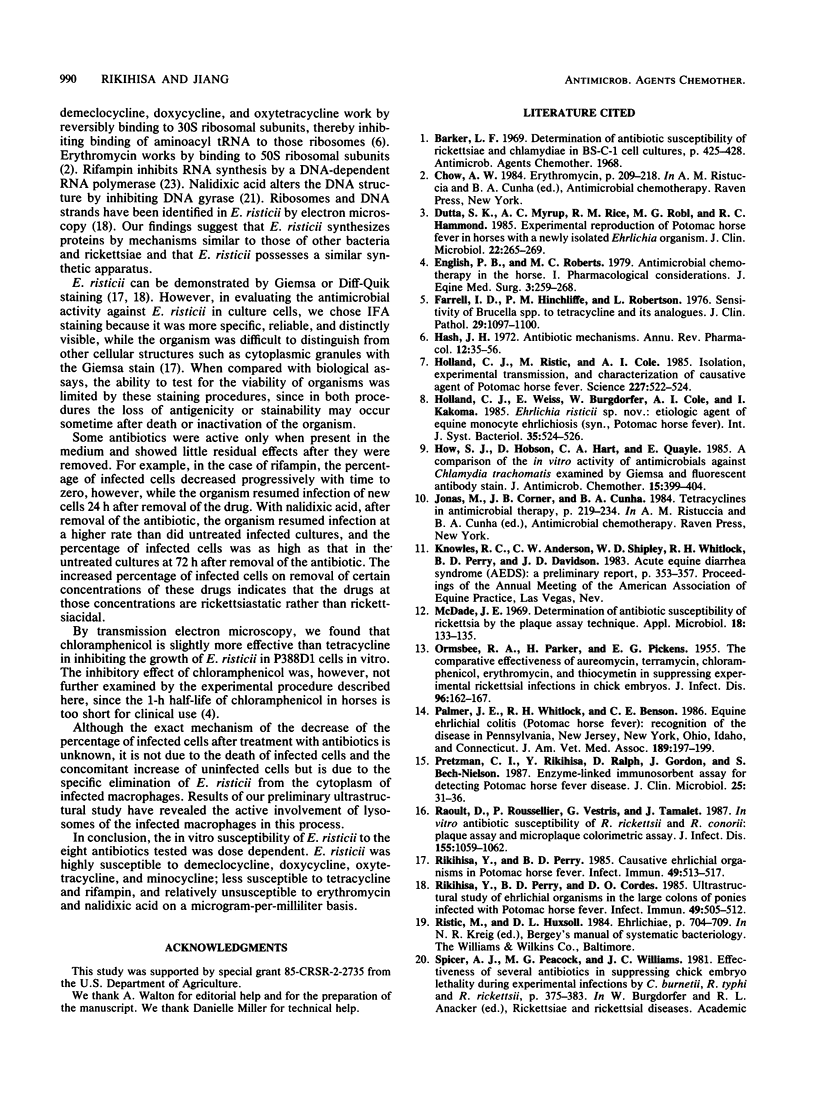
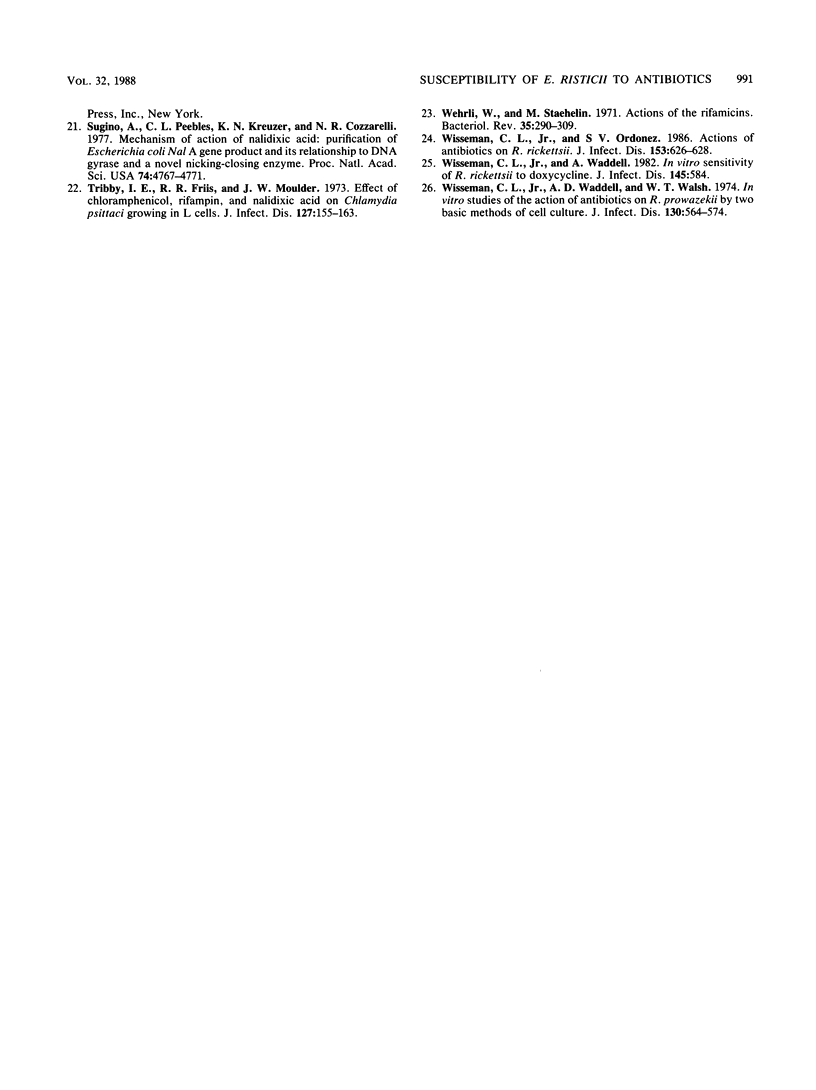
Selected References
These references are in PubMed. This may not be the complete list of references from this article.
- Dutta S. K., Myrup A. C., Rice R. M., Robl M. G., Hammond R. C. Experimental reproduction of Potomac horse fever in horses with a newly isolated Ehrlichia organism. J Clin Microbiol. 1985 Aug;22(2):265–269. doi: 10.1128/jcm.22.2.265-269.1985. [DOI] [PMC free article] [PubMed] [Google Scholar]
- Farrell I. D., Hinchliffe P. M., Robertson L. Sensitivity of Brucella spp to tetracycline and its analogues. J Clin Pathol. 1976 Dec;29(12):1097–1100. doi: 10.1136/jcp.29.12.1097. [DOI] [PMC free article] [PubMed] [Google Scholar]
- Hash J. H. Antibiotic mechanisms. Annu Rev Pharmacol. 1972;12:35–56. doi: 10.1146/annurev.pa.12.040172.000343. [DOI] [PubMed] [Google Scholar]
- Holland C. J., Ristic M., Cole A. I., Johnson P., Baker G., Goetz T. Isolation, experimental transmission, and characterization of causative agent of Potomac horse fever. Science. 1985 Feb 1;227(4686):522–524. doi: 10.1126/science.3880925. [DOI] [PubMed] [Google Scholar]
- How S. J., Hobson D., Hart C. A., Quayle E. A comparison of the in-vitro activity of antimicrobials against Chlamydia trachomatis examined by Giemsa and a fluorescent antibody stain. J Antimicrob Chemother. 1985 Apr;15(4):399–404. doi: 10.1093/jac/15.4.399. [DOI] [PubMed] [Google Scholar]
- McDade J. E. Determination of antibiotic susceptibility of Rickettsia by the plaque assay technique. Appl Microbiol. 1969 Jul;18(1):133–135. doi: 10.21236/ad0857810. [DOI] [PMC free article] [PubMed] [Google Scholar]
- ORMSBEE R. A., PARKER H., PICKENS E. G. The comparative effectiveness of aureomycin, terramycin, chloramphenicol erythromycin, and thiocymetin in suppressing experimental rickettsial infections in chick embryos. J Infect Dis. 1955 Mar-Apr;96(2):162–167. doi: 10.1093/infdis/96.2.162. [DOI] [PubMed] [Google Scholar]
- Palmer J. E., Whitlock R. H., Benson C. E. Equine ehrlichial colitis (Potomac horse fever): recognition of the disease in Pennsylvania, New Jersey, New York, Ohio, Idaho, and Connecticut. J Am Vet Med Assoc. 1986 Jul 15;189(2):197–199. [PubMed] [Google Scholar]
- Pretzman C. I., Rikihisa Y., Ralph D., Gordon J. C., Bech-Nielsen S. Enzyme-linked immunosorbent assay for Potomac horse fever disease. J Clin Microbiol. 1987 Jan;25(1):31–36. doi: 10.1128/jcm.25.1.31-36.1987. [DOI] [PMC free article] [PubMed] [Google Scholar]
- Raoult D., Roussellier P., Vestris G., Tamalet J. In vitro antibiotic susceptibility of Rickettsia rickettsii and Rickettsia conorii: plaque assay and microplaque colorimetric assay. J Infect Dis. 1987 May;155(5):1059–1062. doi: 10.1093/infdis/155.5.1059. [DOI] [PubMed] [Google Scholar]
- Rikihisa Y., Perry B. D. Causative ehrlichial organisms in Potomac horse fever. Infect Immun. 1985 Sep;49(3):513–517. doi: 10.1128/iai.49.3.513-517.1985. [DOI] [PMC free article] [PubMed] [Google Scholar]
- Rikihisa Y., Perry B. D., Cordes D. O. Ultrastructural study of ehrlichial organisms in the large colons of ponies infected with Potomac horse fever. Infect Immun. 1985 Sep;49(3):505–512. doi: 10.1128/iai.49.3.505-512.1985. [DOI] [PMC free article] [PubMed] [Google Scholar]
- Sugino A., Peebles C. L., Kreuzer K. N., Cozzarelli N. R. Mechanism of action of nalidixic acid: purification of Escherichia coli nalA gene product and its relationship to DNA gyrase and a novel nicking-closing enzyme. Proc Natl Acad Sci U S A. 1977 Nov;74(11):4767–4771. doi: 10.1073/pnas.74.11.4767. [DOI] [PMC free article] [PubMed] [Google Scholar]
- Tribby I. I., Friis R. R., Moulder J. W. Effect of chloramphenicol, rifampicin, and nalidixic acid on Chlamydia psittaci growing in L cells. J Infect Dis. 1973 Feb;127(2):155–163. doi: 10.1093/infdis/127.2.155. [DOI] [PubMed] [Google Scholar]
- Wehrli W., Staehelin M. Actions of the rifamycins. Bacteriol Rev. 1971 Sep;35(3):290–309. doi: 10.1128/br.35.3.290-309.1971. [DOI] [PMC free article] [PubMed] [Google Scholar]
- Wisseman C. L., Jr, Ordonez S. V. Actions of antibiotics on Rickettsia rickettsii. J Infect Dis. 1986 Mar;153(3):626–628. doi: 10.1093/infdis/153.3.626. [DOI] [PubMed] [Google Scholar]
- Wisseman C. L., Jr, Waddell A. D., Walsh W. T. In vitro studies of the action of antibiotics on Rickettsia prowazeki by two basic methods of cell culture. J Infect Dis. 1974 Dec;130(6):564–574. doi: 10.1093/infdis/130.6.564. [DOI] [PubMed] [Google Scholar]
- Wisseman C. L., Waddell A. In vitro sensitivity of Rickettsia rickettsii to doxycycline. J Infect Dis. 1982 Apr;145(4):584–584. doi: 10.1093/infdis/145.4.584. [DOI] [PubMed] [Google Scholar]


